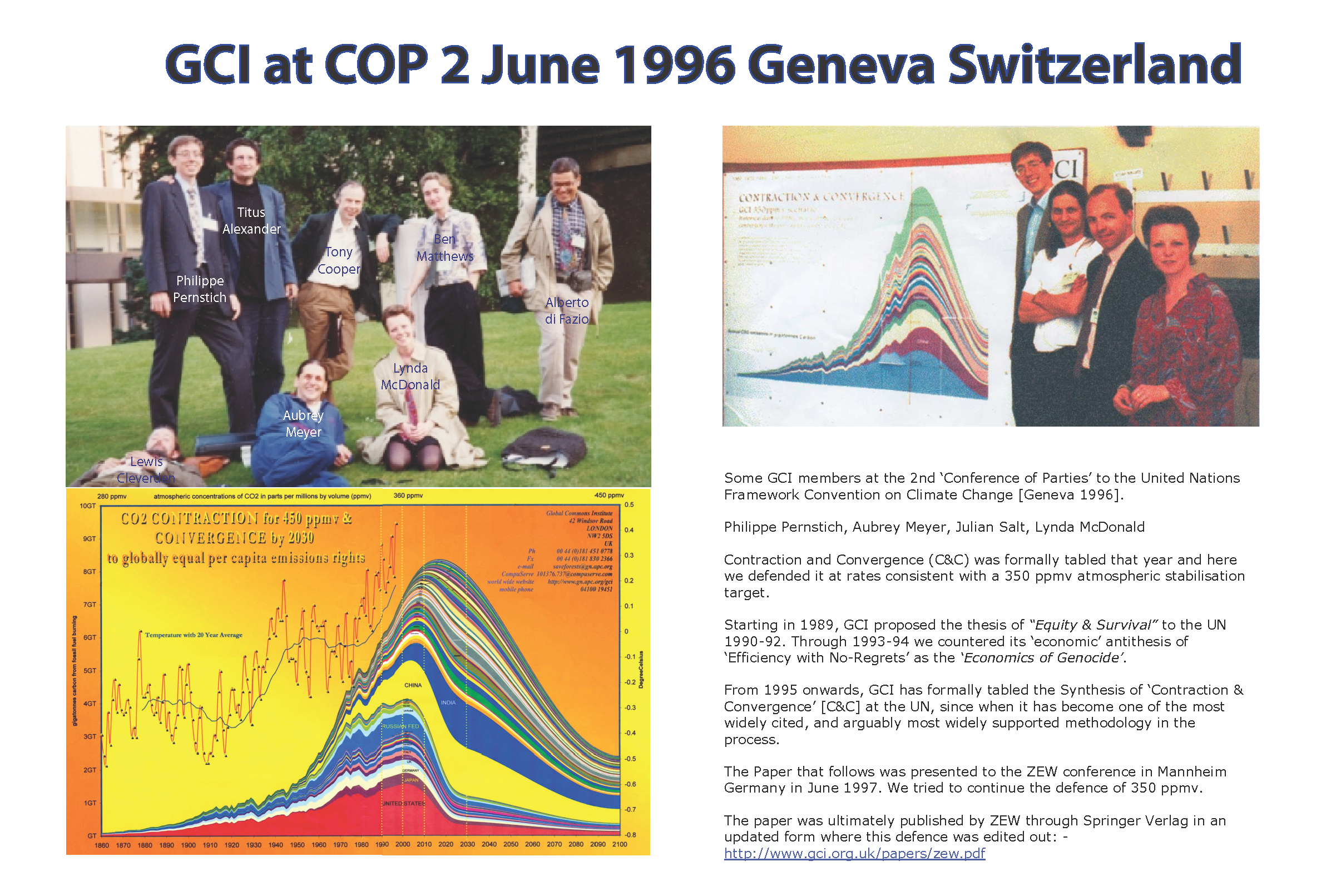Since 1990 C&C has always been 'The Well Tempered Climate Accord'
i.e. uniting to do enough soon enough to achieve UNFCCC-Compliance
True Story about the US & C&C pre COP-3
 Click logo to return to 'links-page'
Click logo to return to 'links-page'
Here is a true & revealing story about C&C in relation to the US Government's early attempts to deal with this (now) crisis.
In April 1997 there was an 'inter-sessional meeting' in Bad Godesburg, nine months prior to COP-3 Kyoto in December.
Introduced at COP-2 1996, by the early 1997 stage of the process, this image had already become very widely known indeed.
Danny Reifsnyder, a friend on the US delegation & Chair of the Ad Hoc Group on the Berlin Mandate, came over and said,
"Hey Aubrey, what do you think of this?" He produced the US presentation for their Press Conference the following day.
I looked at it a while and then said to him, "this looks like Contraction & Compulsion to me," he laughed.
Then I said, "let me look at it overnight and tell you tomorrow what I really think." He said "OK."
Next morning I said to him, "how much are you prepared to pay me not to support you."
He said, "WTF are you talking about!" (of course later I realised that Well Tempered Fifths have everything to do with it).
So I said to him, "you guys are saying that all countries (globally) must have a Quantified Limitation or Reduction Objective (QUELRO) for the US to participate.
At the same time you have left an empty pair of square brackets next to each country as to what their specific QUELRO would be." He agreed.
So I asked him, "how will it be decided what these numbers are and who/what will decide them all?" He shrugged.
So then I said, "I dropped a C&C global number-set for all countries into your square brackets, & (aside from picking numbers
at random out of rows in a cascade of multiple hat-shops), there's no other way to do it."
He said, "let me talk to my guys; I'll come back." Twenty minutes later he came back & said, "Guess what? You don't get paid."
I said, "Uhu - so you want the support." He said, "Yes we do; keeping to what you said, will you speak at our press conference tomorrow?"
So I said, "there will be a bloodbath if I do, but the answer is yes" . . . He said, "that's your problem and thanks."
In what became a long & fractious press conference, I eventually did say that and yes . . . there was a bloodbath (some NGOs went ballistic).
However, afterwards Government-invitations came to visit Washington & Beijing which were accepted.
The Byrd Hagel Resolution was signed on that basis; Jo Biden & John Kerry were part of the 95:0 support
The Africa Group produced a clear statement. With all this we nearly made history at COP-3 but the UK alone refused it.
A member of Robin Cook's 'Green Globe Task Force' (James Cameron) said to me privately at COP-3 Kyoto, "we know its right but we can't support it & we won't".
The story progressed from there and support for the idea became vast.
More about these early years is here.
* In 2008 the UK Climate Act came to be based on C&C.
* In 2009 the Chinese advocated a perfectly logical application of C&C.
C&C & the Rajan 'Global Carbon Incentive'
Am I really the only one who still takes the point? I hope not but I don't think so either (FT letter).
But if at this stage that message remains unheard, it seems we're probably doomed.
"In Leslie Hook’s interview piece with John Kerry (Report, July 21), the US climate envoy said of climate funding that
“President Biden is trying to figure out what to do”. He added: “We can’t be doing less than a totally fundamental,
basic level of acceptance and responsibility.”
As cosignatories to the Byrd-Hagel resolution, both Biden and Kerry know this, as the resolution insisted that
all countries accept either emissions reduction or limitation commitments. It was passed 95-0 by the US Senate in June 1997.
Later that year, at the COP3 meeting of the UN Framework Convention on Climate Change, the resolution fed into what was
very widely known as contraction and convergence (C&C), which the US introduced into the final debate — supported by China,
India and the Africa group of nations — not least to ensure “emissions-trading” was included.
It is fundamental to note that the US delegation specifically accepted the simple basis of “entitlement” as converging on the
global per capita average of emissions under a global cap on emissions. They asked the Global Commons Institute to advocate
for this framework as widely as possible, especially in China, which GCI duly did.
There was widespread acceptance of this principle after COP3. It even became the basis of the UK Climate Change Act in 2008.
At COP15 in 2009 China carefully distinguished between actual emissions and emissions entitlements, pointing out that differences
between emissions above and below the average could and should, as “credits and debits”, be traded or taxed away.
Sadly squandering all these precedents, we have now wasted 24 years since COP3 as the global annual output of CO2 emissions
has now doubled to about 14bn tonnes a year of carbon and in Kerry’s words elsewhere, we are now writing humanity’s “suicide note”.
In his Reith lectures Mark Carney, UN special envoy on climate action and finance, described C&C as the first best option,
at the same time adding that it was never going to happen. But that begs a question: so what framework, if not C&C,
will COP26 deliver which is better? Are we to have a comprehensive framework-based-market,
or just another hit-and-miss market-based-framework?"
Colin Challen Former Chair, All-Party Parliamentary Group on Climate Change
Robin Stott Executive member, UK Climate & Health Alliance
Bill McGuire Professor Emeritus of Geophysical & Climate Hazards
Aubrey Meyer Director, Global Commons Institute
Where it was at COP-2 Geneva 1996
'Contraction & Convergence' (C&C) was introduced to the UNFCCC
at COP-2 in Geneva in 1996. Here is a picture of GCI at that event.
Little did we realize at that time how much the effect and the relevance of that intervention would grow.
